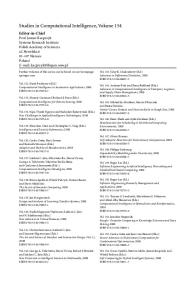Soft Computing for Biological Systems
This book explains how the biological systems and their functions are driven by genetic information stored in the DNA, and their expression driven by different factors. The soft computing approach recognizes the different patterns in DNA sequence and
- PDF / 6,234,048 Bytes
- 301 Pages / 439.42 x 683.15 pts Page_size
- 23 Downloads / 322 Views
omputing for Biological Systems
Soft Computing for Biological Systems
Hemant J. Purohit • Vipin Chandra Kalia • Ravi Prabhakar More Editors
Soft Computing for Biological Systems
Editors Hemant J. Purohit Environmental Biotechnology and Genomics Division CSIR-National Environmental Engineering Research Institute (NEERI) Nagpur, Maharashtra, India
Vipin Chandra Kalia Microbial Biotechnology and Genomics CSIR-Institute of Genomics and Integrative Biology (IGIB) Delhi University Campus Delhi, India
Ravi Prabhakar More ADBS, Lab 18, Neural Stem Cell Program TIFR-National Centre for Biological Sciences Bangalore, Karnataka, India
ISBN 978-981-10-7454-7 ISBN 978-981-10-7455-4 https://doi.org/10.1007/978-981-10-7455-4
(eBook)
Library of Congress Control Number: 2018931480 # Springer Nature Singapore Pte Ltd. 2018 This work is subject to copyright. All rights are reserved by the Publisher, whether the whole or part of the material is concerned, specifically the rights of translation, reprinting, reuse of illustrations, recitation, broadcasting, reproduction on microfilms or in any other physical way, and transmission or information storage and retrieval, electronic adaptation, computer software, or by similar or dissimilar methodology now known or hereafter developed. The use of general descriptive names, registered names, trademarks, service marks, etc. in this publication does not imply, even in the absence of a specific statement, that such names are exempt from the relevant protective laws and regulations and therefore free for general use. The publisher, the authors and the editors are safe to assume that the advice and information in this book are believed to be true and accurate at the date of publication. Neither the publisher nor the authors or the editors give a warranty, express or implied, with respect to the material contained herein or for any errors or omissions that may have been made. The publisher remains neutral with regard to jurisdictional claims in published maps and institutional affiliations. Printed on acid-free paper This Springer imprint is published by the registered company Springer Nature Singapore Pte Ltd. part of Springer Nature. The registered company address is: 152 Beach Road, #21-01/04 Gateway East, Singapore 189721, Singapore
Dedicated to our mentors and inspiration – the respected Mr. Dashrath Manjhi: The Mountain Man
Preface
The biological systems and their functions are driven by information stored in the genetic material, the DNA, and their expression is driven by different factors. The active units of these DNA sequences are genes, which also interact with each other to define a condition-specific expression. The soft computing approaches recognize the different patterns in DNA sequence and assign them biological relevance with available information. At times these patterns not only help in the classification of but also predict functionally active domains. These approaches are equally helpful in predicting protein-protein interaction. To understand any stressed scenario, th
Data Loading...











